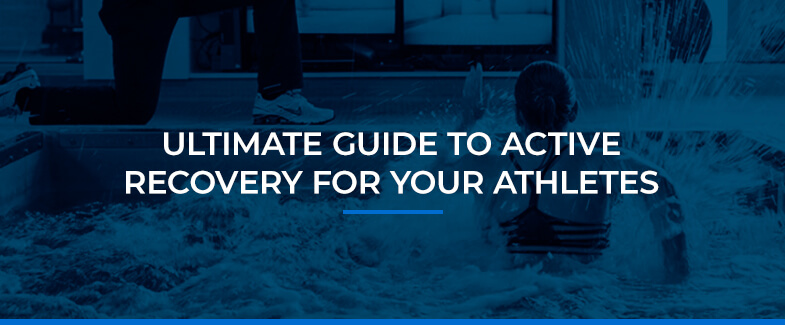Ultimate Guide to Active Recovery for Your Athletes
After a vigorous workout, is it better for an athlete to rest on the couch or to participate in another form of less intense exercise? With some exceptions, active recovery — or taking things a little bit more slowly than usual — is often the best way to bounce back from a challenging workout. Whether you work with long-distance runners, avid bodybuilders or high-intensity interval training enthusiasts, scheduling a few active recovery days into your clients’ fitness routine can help their muscles recover from the most strenuous workouts.
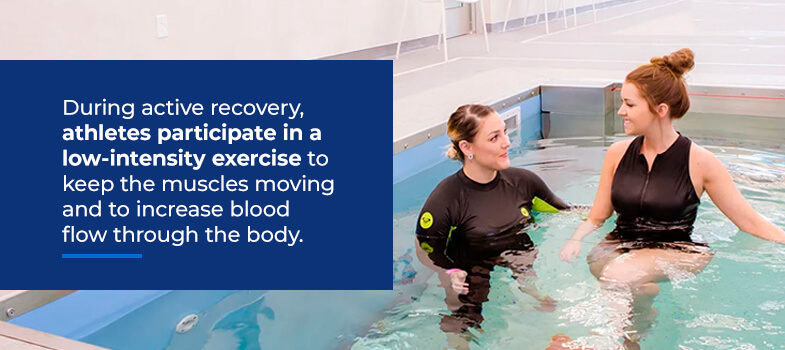
What Is Active Recovery?
Active recovery turns the old belief that rest was necessary for muscle growth on its head. During active recovery, athletes participate in low-intensity exercise to keep the muscles moving and to increase blood flow through the body. Though active recovery activities stimulate blood flow and encourage movement, they don’t put additional strain on the muscles. Trading some passive recovery days for active ones can help you maximize your clients’ fitness routine or allow them to train more effectively for a marathon or another competition.
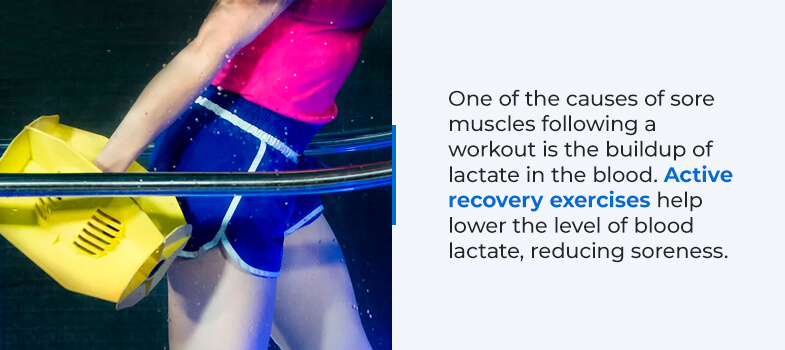
Active Recovery vs. Passive Recovery
Active recovery and passive recovery are both forms of rest, but there are crucial differences between the two. The exact definition of passive recovery can vary based on who you ask. Some might say taking a full day off from exercise counts as passive recovery. The muscles have a chance to rest and recover fully. Passive recovery activities might include sitting on the couch and watching TV or relaxing with a book.
HydroWorx considers passive recovery to be something less strenuous than active recovery but that still helps the recovery process after exercise.
However you define it, some instances demand passive recovery instead of active recovery. If someone is injured, it’s often better to completely rest instead of trying to push through with low-impact exercise. Passive recovery is also beneficial if an athlete feels excessively fatigued after working out.
To determine when passive recovery is necessary or if your clients can benefit from it, it helps to tell the difference between sore muscles and injured muscles. One sign of an injury is immediate, acute pain. In contrast, it usually takes a day or two for soreness to develop. Injuries also typically cause sharp pain in the specific, hurt area. Soreness tends to be an achy, dull feeling that can occur all over.
Another sign of injury is loss of motion in the affected area and weakness. If it’s hard to move or if your client can’t complete exercises as usual, the muscle might be injured. Along with fully resting the muscle, it’s a good idea for them to have it examined by a medical professional.
In the case of muscle soreness, active recovery can help. One of the causes of sore muscles following a workout is the buildup of lactate in the blood. Active recovery exercises help lower the level of blood lactate, reducing soreness.
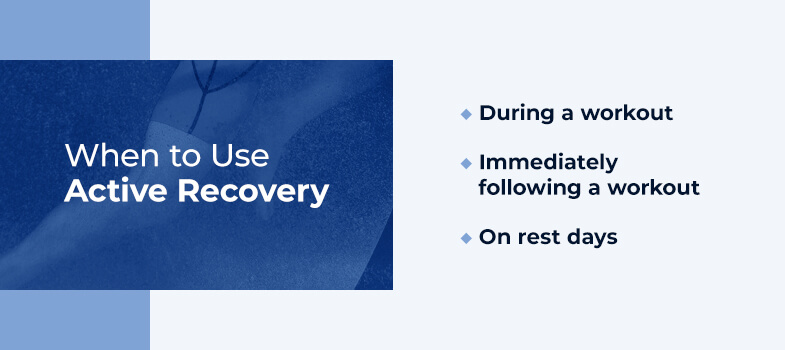
When to Use Active Recovery
There are several times when it makes sense for athletes to participate in active recovery.
- During a workout: Fitting active recovery into a workout can help the body recover faster afterward. Active recovery can be particularly beneficial during a high-intensity interval workout. For example, an athlete might do a set of burpees, followed by a minute or two of cycling at a relaxed pace on a stationary bike. After bench-pressing a heavy weight, they can take a lap or two around the gym.
- Immediately following a workout: The cool-down after a workout is as essential as the warmup. Cooling down helps control blood flow and allows the heart rate and blood pressure to return to normal. Active recovery exercises to try after a vigorous workout can include gentle yoga, walking or swimming. The cool-down activity doesn’t have to be very long. People might see benefits after only 10 minutes.
- On rest days: Incorporating active recovery exercises into rest days can help alleviate soreness. For example, the day after a HIIT workout, schedule a 30-minute Hatha yoga session. A day or two after your client completes a long-distance run, have them sit in a plunge pool. For maximum benefits, alternate between warm and cold plunges, also known as contrast water therapy.
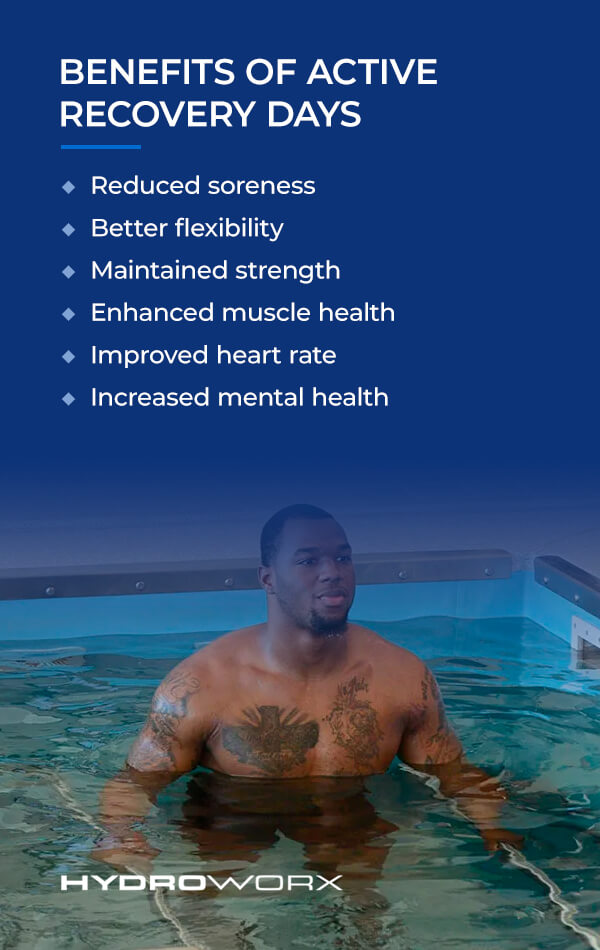
Benefits of Active Recovery Days
Active recovery helps athletes bounce back after workouts or intense trainings. Some of the notable benefits of active rest or recovery include the following.
- Reduced soreness: Whether it’s immediately after a workout or the next day, participating in an active recovery exercise can help eliminate muscle soreness. Low-impact exercise can improve blood circulation, allowing restorative nutrients to reach the muscles.
- Better flexibility: Stretching exercises are often part of active recovery. Gentle stretching can make the muscles more flexible, which is essential for comfort and mobility. If the muscles are stiff, it can be challenging to perform daily tasks or the range of motion can become limited.
- Maintained strength: Taking it down a notch or two a few days a week, rather than fully resting, can help athletes maintain all the progress they’ve made with their strength and endurance. People who work out on days when they would have otherwise passively rested can keep a sense of routine, which can help them stay consistent with their workouts.
- Enhanced muscle health: During strenuous exercise, the body produces lactate, which can turn into energy without oxygen. Depending on the exercise’s intensity, the body can produce too much lactate buildup in the muscles. Active recovery can keep lactate levels in check, helping the muscles stay healthy. Sitting in hot and cold plunge pools on days off or after a workout can help expel lactic acid from the muscles.
- Improved heart rate: Low-impact exercises safely lower the heart rate following an intense workout. Gradually decreasing the heart rate can also keep lactic acid levels in check.
- Increased mental health: Depending on the type of exercise athletes do, vigorous workouts can put a lot of strain on their mental capacity. Relax or take it easy by scheduling low-impact exercises a few times a week. Some exercises, such as yin yoga or tai chi, incorporate a mindfulness element that can further ease their mind.
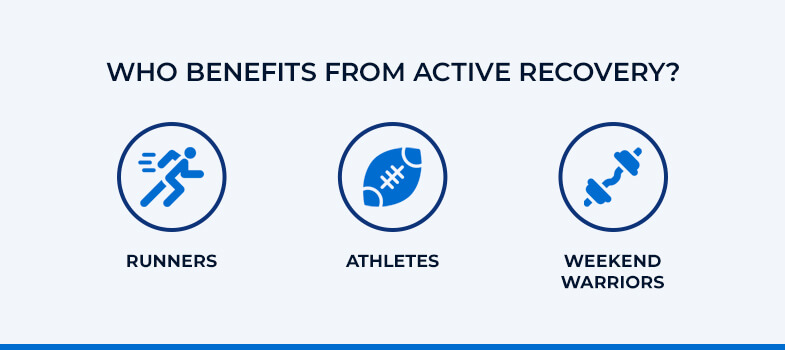
Who Benefits From Active Recovery?
Athletes who regularly engage in physically strenuous activities are most likely to benefit from active recovery, either immediately following a workout or on a rest day. Take a look at a few examples of people who might do well by incorporating active recovery into their routines.
Runners
Whether they’re training for a marathon or would like to complete their first 5K race, runners can benefit from a few active recovery days in their weekly training schedule. Runners also benefit from a few passive rest days. As a trainer, you have a few options for working active recovery into your clients’ running routine. People who are training for a specific race might decide to incorporate leisurely, slower-paced runs into their weekly workout schedule, alternating with more intense, faster or longer runs.
Another way to work active recovery into a workout routine is to schedule cross-training activities on a day off from running. Runners might participate in a yoga class or go for a slow-paced swim rather than a long run on an active rest day. A cold plunge pool can help reduce muscle soreness and inflammation after a run.
Athletes
If you train people who play an organized sport, such as soccer or football, active recovery exercises can help them perform better on the field. One small study of 22 male athletes examined the effect active recovery — in the form of a bike ride — had on lactate buildup in the muscles. The study compared active recovery to passive recovery and self-myofascial release exercise using a foam roller. It found that self-myofascial release and riding a bike were more effective at reducing lactic acid levels in the blood compared to passive recovery.
Whatever your clients’ sport of choice is, allowing room for an active recovery exercise when they aren’t training or playing a game can help improve their overall strength and condition. Using an underwater treadmill can help athletes recover, reducing lactic acid buildup and keeping the muscles strong, while also minimizing pressure and force on their joints.
Weekend Warriors
A weekend warrior is a person who gets their recommended 150 minutes of moderate activity or 75 minutes of vigorous activity for the week in one fell swoop, usually over the weekend. Compared to insufficiently active or completely inactive people, weekend warriors have a reduced risk of death from heart disease.
Fitting the weekly recommended physical activity in over only one or two strenuous exercise sessions can leave people feeling sore and fatigued during the rest of the week. For that reason, active recovery is as vital for weekend warriors as it for athletes and daily exercise enthusiasts.
If you train a weekend warrior, schedule an active recovery exercise a day or two after their weekend sprint. Another option is to develop weekend activities with a built-in cooldown component.
Things to Do on Active Recovery Days
Not sure what type of exercise to try on your clients’ next active recovery day? Here are a few ideas of what to do on an active rest day. Experiment with one or more to see which one works best for your athletes. The essential thing is to choose an activity they’re likely to stick with and incorporate into their fitness routine.
Yoga
Yoga is a low-impact workout that improves flexibility while strengthening the muscles. Some argue that hot yoga, performed in an intentionally heated studio, has more benefits than regular yoga. Still, anyone is likely to see an improvement in muscle soreness no matter which forms they choose.
If you’re going to try yoga for your clients, keep in mind that some forms are more appropriate for active recovery than others. Save the power yoga for when you need an intense sweat session. Yoga options for active recovery include Hatha and yin. Yin yoga involves holding poses for about five minutes, allowing athletes to get a thorough stretch in. Hatha yoga is a gentle flow of movement that incorporates breathing and meditation.
While you can find plenty of yoga videos online or on DVD, it’s a good idea to take a class or work with a private yoga teacher if you’re brand-new to the exercise. A teacher can demonstrate the correct way to sink into poses, minimize strain or help you avoid injury. If your athletes have difficulty with specific poses, an instructor can show you modifications or adaptations to fit their body’s needs.
Cycling
Like yoga, some types of cycling are better for active recovery days than others. You probably don’t want to try and push your clients to the limit when cycling on an active rest day, nor do you want them to go for a taxing mountain bike ride.
Instead, ride for about 30 minutes at a moderate or even slow pace on a stationary bike on active recovery days. You can also take a road bike out for a spin. To make sure you’re not overdoing it, ask athletes to pay attention to their heart rate. It shouldn’t get too elevated. It should stay below an individual’s target heart rate, which is 50% to 85% of the maximum heart rate, depending on age and fitness level. If they feel like they’re pushing themselves, they’re likely using too much effort and can afford to scale things back.
In addition to helping athletes recover from more vigorous workout sessions, cycling also reduces the force and pressure on the joints. If your clients go for a bike ride on the street or a trail, remind them to wear a helmet and follow the road rules, such as stopping at traffic lights and yielding to pedestrians.
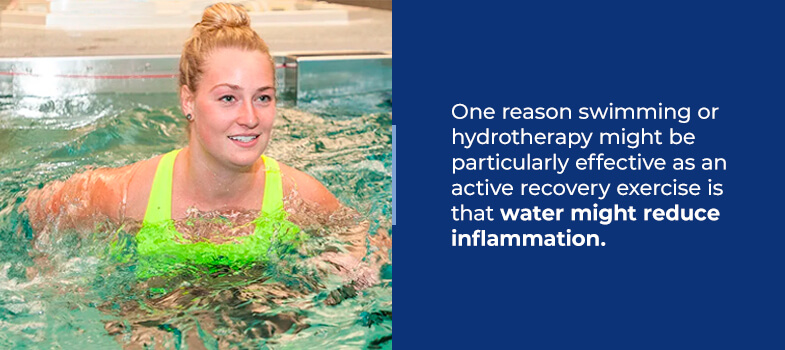
Swimming or Hydrotherapy
Swimming can be a low-impact exercise that minimizes pressure on the joints. One study that examined the benefits of hydrotherapy for older adults found that people who exercised using an underwater treadmill twice a week, in addition to already exercising three days per week, reported improved quality of life, including better sleep habits and an improvement in flexibility.
One reason swimming or hydrotherapy might be particularly effective as an active recovery exercise is that water might reduce inflammation. Another study found that triathletes who swam after completing high-intensity training performed better when they exercised the next day.
Tai Chi
Tai chi is sometimes called “meditation in motion.” It developed from a series of self-defense exercises that flow together without stopping. This practice combines stretching with gentle movements and controlled breathing.
Doctors sometimes recommend tai chi for older adults who might not be physically active and are looking for low-impact forms of exercise. It’s also good for active rest days, as the movements work the muscles without too much stress or strain.
If you’re only getting started with tai chi, it can be helpful to work with an instructor rather than try to do the postures and movements on your own. A teacher can demonstrate the proper form and can help make sure you’re doing the exercises correctly. As there are several different forms of tai chi, you might want to try several to find the one your clients like best. Once they have the moves down, they can do tai chi anywhere, such as at the park.
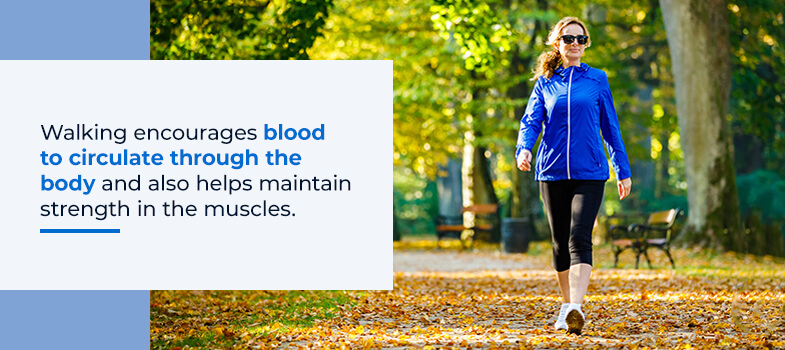
Walking
Whether it’s after a strenuous workout or on a rest day, taking a walk is a leisurely and enjoyable way to help the muscles recover. Walking encourages blood to circulate through the body and also helps maintain strength in the muscles.
Ask your athletes to pay close attention to their posture and position as they walk. Ideally, their heads will be level, looking forward, not down. They want to stand up straight but not hold their body so rigidly that their neck and shoulders are stiff. Their arms can swing at their sides as they move, and you might even recommend that they pump their arms back and forth gently.
To protect their feet, everyone should wear a pair of comfortable, well-cushioned and supportive walking shoes when they take a walk. As they put their feet down on the ground, move from heel to toe.
Hiking
Think of hiking as a more meditative form of walking. You’re out in nature, taking in the sights and sounds. Hiking can be a form of vigorous activity, but if you choose a flat, relatively even trail, it can also be a good option for active recovery days.
What sets a hike apart from a walk? Location matters, for one thing. If your athletes take a hike, ensure they do so in a local park or natural setting. For safety, stay on the marked trails. As with walking, it’s essential to wear the correct footwear when hiking. Hiking boots or shoes that provide ankle support and traction on the soles are ideal.
Along with helping athletes recover from vigorous workouts, hiking can also give their mental health a boost. Taking a 90-minute hike in a natural setting has proven to reduce rumination — repetitive, negative thinking.
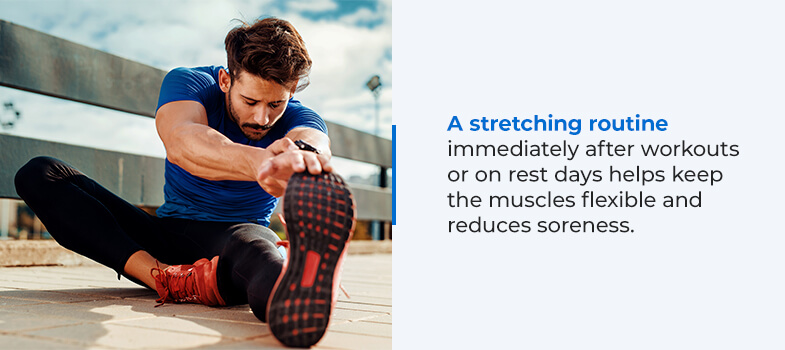
Stretching
A stretching routine immediately after workouts or on rest days helps keep the muscles flexible and reduces soreness. Without stretching, there’s a chance the muscles will tighten, becoming weak and less able to move when athletes start their vigorous exercise routine again. Ideally, a stretching routine will include dynamic as well as static stretches.
Dynamic stretches use controlled movements, such as twisting or lunging, to prepare the muscles for future movements. When performing static stretches, people should hold still. Examples of static stretches include touching the toes or bending the leg from the knee to stretch the quadriceps. For best results, hold static stretches for about 30 seconds on each side. Keep the muscle still while stretching, as bouncing can lead to injury.
Foam Rolling
Self-myofascial release, also known as foam rolling, is a type of massage that focuses on the connective tissue. Use a foam roller to massage overextended areas of the body. The roller can reduce inflammation, improve range of motion and lessen muscle soreness.
For best results, learn how to alleviate sore muscles with a foam roller before you start. Once they have the correct technique down, your clients can perform self-myofascial release exercises alone or as part of an active recovery stretching routine.
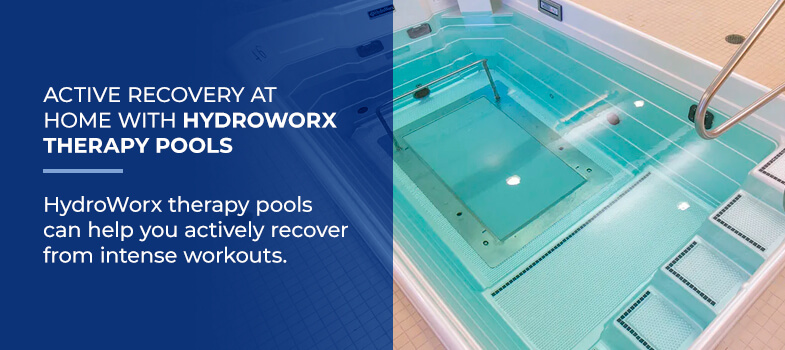
Active Recovery With HydroWorx Therapy Pools
HydroWorx therapy pools can help you actively recover from intense workouts. The HydroWorx 500 has an underwater treadmill that you can use for low-impact aerobic exercise on an active rest day. Our warm and cold plunge pools feature spa jets that massage trigger points, helping reduce soreness and inflammation of the muscles.
To learn more about our aquatic therapy products and to see where you can try them for yourself to maximize active recovery, contact us today.


